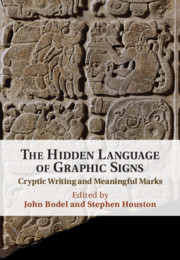Book contents
- The Hidden Language of Graphic Signs
- The Hidden Language of Graphic Signs
- Copyright page
- Contents
- Contributors
- Abbreviations
- Introduction
- Part I Hidden Writing
- Part II Legible Signs
- Seven Marking and Writing in an Egyptian Workmen’s Community
- Eight The Semiotics of Signa and the Significance of Signs in Roman Stamps
- Nine Late Antique and Early Medieval Monograms
- Ten Crests and Familial Identity in Medieval Japan
- Eleven Where Credit’s Due
- Twelve From Modeling to Destruction
- References
- Index
Eleven - Where Credit’s Due
Making Marks and Counting Labor in the Andes
from Part II - Legible Signs
Published online by Cambridge University Press: 23 August 2021
- The Hidden Language of Graphic Signs
- The Hidden Language of Graphic Signs
- Copyright page
- Contents
- Contributors
- Abbreviations
- Introduction
- Part I Hidden Writing
- Part II Legible Signs
- Seven Marking and Writing in an Egyptian Workmen’s Community
- Eight The Semiotics of Signa and the Significance of Signs in Roman Stamps
- Nine Late Antique and Early Medieval Monograms
- Ten Crests and Familial Identity in Medieval Japan
- Eleven Where Credit’s Due
- Twelve From Modeling to Destruction
- References
- Index
Summary
Between the ninth and sixteenth centuries, crests (mon) evolved from ornamental motifs to potent signifiers of social and political identity. Japanese warriors borrowed the use of stylized decorative motifs from the aristocracy, eventually transforming them into full-fledged heraldic markers. Scholars have explained this evolution in fundamentally military terms: absent uniforms, mon enabled warriors to distinguish friends from foes on chaotic battlefields. Yet twelfth- to fourteenth-century representations, in war tales and illustrated scrolls, reveal that the diffusion of mon accelerated in peacetime. Growing attention to mon in sources largely reflects the narrative logics of the various genres: mon served to commemorate battlefield deeds rather than organize military action. Indeed, the impetus for their diffusion was genealogical ‒ a manifestation of the contemporaneous restructuring of warrior society around the corporate warrior house (ie). The ie came to represent the fundamental unit of affiliation for Japanese warriors, with its emphasis on shared ancestry and its hierarchy of lineages and sub-lineages. Mon served as powerful visual markers of the unity and flexibility of these new kinship and political groups, providing a language to represent minute variations of identity and status in a society keenly attentive to both.
Keywords
- Type
- Chapter
- Information
- The Hidden Language of Graphic SignsCryptic Writing and Meaningful Marks, pp. 233 - 255Publisher: Cambridge University PressPrint publication year: 2021

